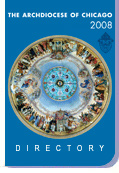|
|
Chicago’s own ‘big 10’
Coaches inducted into Hall of Fame
By Patrick Butler
SPECIAL CONTRIBUTOR
More than a month after learning he was among this year’s 10 inductees
in the Chicago Catholic League Coaches Hall of Fame, St. Rita
High School’s Jay Standring is still asking why.
“There are so many great guys out there. It’s humbling, said the
former Leo High School football, basketball, golf and track star
who in the mid-1960s earned 12 varsity letters before going on
to the Cotton Bowl as a Notre Dame defensive back and punter.
Standring said he was “on cloud nine” when he got the call from
Catholic League Coaches Association President John Hoerster notifying
him that he would be among the honorees at the 40th annual Hall
of Fame dinner earlier this month.
Hoerster understood perfectly because he had gone into the Hall
of Fame “a few years ago. I don’t remember exactly,” after a similarly
meteoric sports career that started at St. Rita in the 1960s.
After Northwestern University, Hoerster was an assistant coach
at Gordon Tech High School for 16 years before moving on to Loyola
Academy, which he took to a state football championship in 1993.
Hoerster’s brother Ed (“Tex”), another of this year’s inductes,
played at St. Rita’s in 1957-59 going on to Notre Dame (where
he captained a Blue/Gray All-Star team) and was drafted by both
the Chicago Bears and Buffalo Bills, opting instead to play with
the Canadian Football League.
This year’s other inductees were:
- Bill Sims, another St. Rita alum, who made All-Catholic, All-City
and All-State in his senior year. He was drafted into the army
in 1942, almost immediately after enrolling at Indiana University,
and played on Ft. Sheridan’s football and basketball teams before
shipping out to the Philippines. At war’s end, he signed with
the Detroit Lions, but was permanently sidelined by a knee injury
during spring practice. He went to work for the Illinois State
Highway Authority and later became a city operating engineer.
- Frederick Wright started as a Loyola Academy coach in 1964 after
being a top wrestler at Cornell College and a finalist in the
1960 Olympic trials. Now a transportation director for the Highland
Park School District, Wright is credited with getting Chicago’s
Catholic League into statewide competition.
- Jerry Schumacher, a defensive end at Mount Carmel High School
in 1966-68, played in two Rose Bowl games on the University of
Michigan squad and later coached for four years at Gordon Tech.
- Art Michalik played football for four years at Weber (and in the
1947 Catholic League All-Star game) before going on to St. Ambrose
College where he was 1948 Athlete of the Year, both because of
his gridiron virtuosity and four undefeated years as a wrestler.
After college, he was drafted by both the San Francisco 49ers
and Uncle Sam, who kept Michalik busy with football and wrestling
at the Treasure Island Naval Base in San Francisco Bay until 1953,
when he returned to the 49ers. He later moved on to the Pittsburgh
Steelers and the Calgary Stampeders. After retiring from pro sports
in 1964, Michalik spent 32 years as a high school teacher and
coach.
- Gerald Darda, a Fenwick All-American swimmer, became captain of
Purdue University’s 1960 swim and diving team and was a Big 10
diving championship finalist. He became a teacher and coach at
the urging of mentor Dan O’Brien who spent 60 years at Fenwick,
starting as a freshman football player. During his own 30 years
at the University of Wisconsin/Madison, Darda trained two Olympians
and 11 international teams, including the 1972 U.S. Olympic diving
squad.
- Ken Geiger boxed and played football at Fenwick in the late 1940s
before leading the Monmouth College gridiron squad to an undefeated
conference championship. He coached wrestling and football at
Morton High School for 34 years before scouting for the Chicago
Bears, the Indianapolis Colts and the New Orleans saints.
- This year’s one inductee who was never a player or coach is Sun-Times
reporter Taylor Bell, who has covered high school sports for the
past 33 years. “He pushed prep sports. And he pushed the Catholic
League,’’ said Jim Righeimer, one of the nine-member committee
that picked the 2001 Hall of Famers.
- The oldest 2001 Hall of Famer, Clarence Rube Marquardt was a Fenwick
fullback in 1936 when Fenwick won the Catholic League title and
tied with Austin High School for the citywide championship.
Also a sprinter, Marquardt won the 100- and 220-yard dash in the
NCL track championships and turned to track after his football
career was cut short by a shoulder injury during his first year
at Notre Dame.
“I don’t know what happened to him after that,” said Righeimer,
who coached at St. Philip, St. Ignatius and Weber and like Standring
was “surprised” at becoming a Hall of Famer, especially since
he was only 41 at the time of his 1973 induction.
“It’s rare to get in the first time your name comes up. It usually
takes a few years,” said Righeimer, who said “maybe 350” have
been inducted since the Hall of Fame was founded by O’Brien and
the late Tony Lawless, another legendary Fenwick coach.
“It gets harder every year’’ to make selections, says O’Brien.
“Obviously, you’ve got so many more good candidates to choose
from than when we first started.”
And if today’s coaches are doing their jobs, “It’ll only get harder,’’
O’Brien said.
Front Page | Digest | Cardinal | Interview
Classifieds | About Us | Write Us | Subscribe | Advertise
Archive | Catholic Sites | New World Publications | Católico | Directory | Site Map
|





